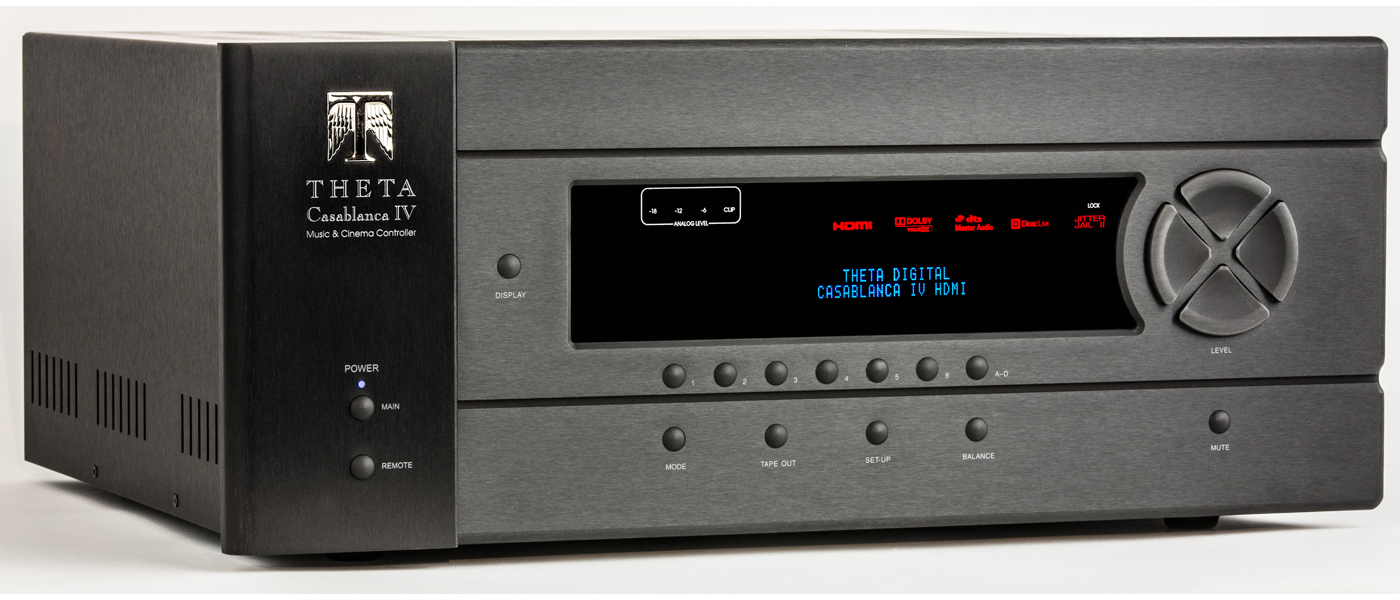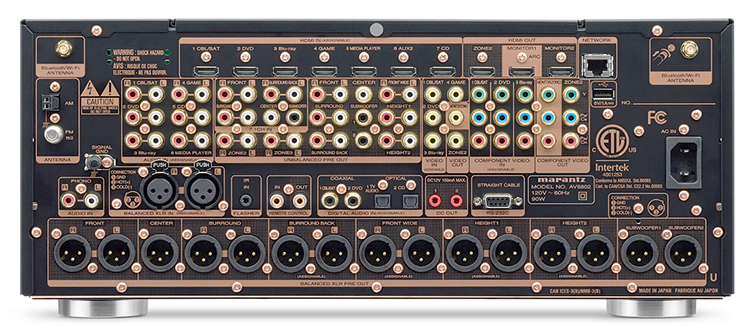Marantz includes the full version of the Audyssey Platinum suite which features Audyssey MultEQ XT32 room correction. The AV8802 also supports Auro-3D via an optional paid software upgrade and it can be hardware upgraded to the AV8802A, which provides full support for HDMI 2.0a, HDCP 2.2, Rec. 2020 color gamut, and 4K HDR video. The AV8802 delivers an immersive theater-like experience and is a major update to the prior flagship Marantz AV8801 processor.
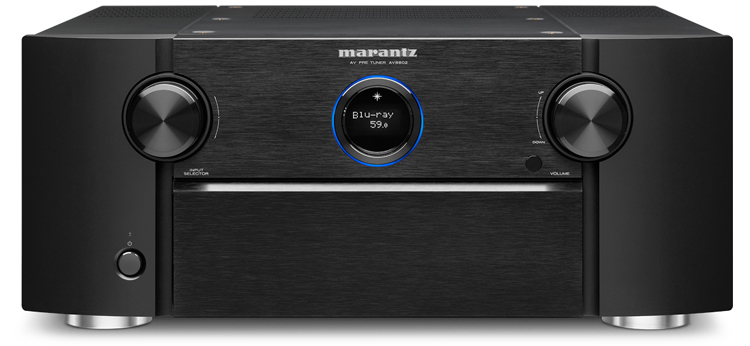
Marantz AV8802 11.2 Surround Sound Processor (SSP)
- Includes Dolby Atmos and Dolby Surround processing to create an immersive 3D surround experience.
- Includes the Audyssey Platinum room correction suite (Audyssey MultEQ XT32, Dynamic EQ, Dynamic Volume, Sub EQ HT, and LFC) and Audyssey DSX processing.
- Auro-3D decoding and the Auro-3D upmixer are available with a paid upgrade.
- DTS:X immersive surround processing will be offered as a no-charge upgrade.
- Significantly improved analog output path with improved signal to noise ratio over the AV8801.
- Support for HDCP 2.2, HDMI 2.0a, HDR, Rec. 2020 color gamut, and 4K 60 Hz video passthrough in 4:4:4 color space is provided via a low cost hardware upgrade (nominal charge for one-way shipping).
Marantz has a rich history of building hi-fi products since the 1950’s. Their merger with Denon to create D+M Holdings back in 2002 has resulted in product lines that are both feature rich and faithful to the original musical heritage of the company. The Marantz AV8802 is their latest flagship processor / preamp and it builds upon the feature set and design of the previous flagship AV8801, which I reviewed two years ago.
Processing
Design:
11.2 Channel Preamp/Processor (SSP)
DACs:
AKM AK4490 32-Bit/192kHz
ADC:
AKM AK5358B
DSP:
Four 32-bit Analog Devices ADSP21487 Processors
Dolby® and DTS® Surround Sound Processing:
Including Dolby Atmos and Dolby Surround
Audyssey DSX®:
Processing
DTS:X:
Processing (No charge future upgrade)
Audyssey Platinum Suite:
(MultEQ XT32, Dynamic EQ, Dynamic Volume, Sub EQ HT, LFC)
Auro-3D Processing:
(Optional $199 upgrade)
Video Upconversion:
(1080p and 4K) for Analog and HDMI Sources
3-Zone:
Operation
Connections
HDMI 2.0 Audio/Video Switching:
8 In (Includes 1 front-panel input), 3 Out
HDMI 2.0a with HDCP 2.2:
Available with AV8802A Upgrade
Component Video Switching:
3 In, 2 Out
Composite Video Switching:
5 in, 2 out (Includes front-panel input)
Digital Audio Inputs:
2 Optical and 2 Coaxial
Analog Audio Inputs:
7 RCA, 1 XLR, 1 Phono, (1) 7.1 Multi-channel
13.2 Channel Pre-outs (RCA and XLR):
Including 2 Independent Subwoofers
USB Ports (2) for Audio Playback:
From USB Storage Devices
Ethernet Port:
For Wired Network Connection
Bluetooth:
Wi-Fi Support
RS-232C, Remote IR (1 in):
Remote Control (1 in, 1 out), and 12 Volt-triggers (2 out)
1/4″:
Headphone Output
2nd Zone (Stereo Audio, HDMI, Composite, Component):
3rd Zone (Stereo Audio)
General Features
4K/60p and 3D Video:
Pass-through
Wi-Fi RemoteApp for Apple:
or Android Devices
HD Radio:
AM/FM Tuner
Remote:
Control
Dimensions w/o Antenna:
7.3″ H x 17.3″ W x 15.3″ D
Dimension with Antenna:
9.8″ H x 17.3″ W x 16.1″ D
Weight:
30 Pounds
MSRP:
$3,999 USD
Company:
SECRETS Tags:
Marantz, Marantz AV8802, Surround Processor, Preamplifier, Dolby Atmos, Auro-3D, Dolby Surround, DTS:X
While both processors support 11.2 channels, the AV8802 now includes support for the immersive object-based Dolby Atmos surround technology and Marantz offers a license upgrade to Auro-3D for $199. Marantz will also offer a free upgrade to DTS:X, which is the competing 3D surround format from DTS. I really enjoyed the Auro-3D demonstrations that I had experienced at CEDIA 2014 and CES 2015, and I was looking forward to seeing how the AV8802 handled both formats in my own home theater.
The exterior of the Marantz AV8802 looks identical to that of the AV8801, with the same clean lines and simple control interface. The front panel only has a power button and two large control knobs, one for volume control and the other for input selection. In the center of the AV8802 is the trademark porthole display that shows the current input selection and volume or tuner band and station.
The porthole display is accented with a small blue ring which is illuminated when the AV8802 is on. The center portion of the front panel is made from brushed aluminum, and the left and right side panels are made from curved resin which gives the processor its refined appearance.
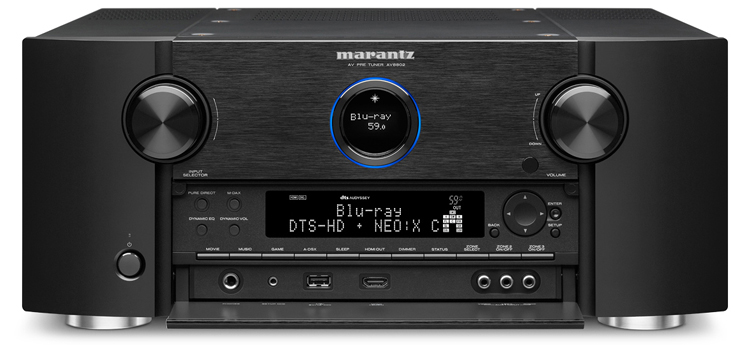
Opening the door at the bottom of the AV8802 reveals a large LED display, which shows the current input source, processing mode, signal type, HDMI status, and zone and channel indicators. To the left of the display are buttons for directly controlling audio processing options such as Audyssey Dynamic EQ and Dynamic Volume. To the right of the display is a standard set of cursor buttons that allow for easy navigation of the AV8802 setup menus as well as its multi-media interface.
Directly under the display are buttons for the various input modes, HDMI output selection, and zone selection. At the bottom of the AV8802 is the headphone jack, the microphone jack for Audyssey, an HDMI port, and a USB port. In the lower-right corner of the AV8802 is an auxiliary input, which provides analog audio inputs and a composite video input. The front panel is otherwise identical to that of the AV8801 with the exception that there is now a separate button for Audyssey DSX which replaces the Zone 4 input button. The AV8802 drops support for a fourth zone.
The rear panel of the AV8802 is quite a bit different from that of the AV8801. The first thing that I noticed was that the four port 10/100 Ethernet hub was no longer included. While I liked this feature, it was definitely a luxury and Marantz needed the space for more goodies. There are fifteen balanced XLR and unbalanced RCA preamp outputs, which include two pairs of height channels, one pair of width channels, and two independent subwoofer channels.
Marantz has included a copper-plated chassis on the AV8802 and the rear panel is silk-screened in black with inputs having a sold black background while outputs have a checkered background. The AV8802 processor supports eight HDMI 2.0 inputs and three HDMI 2.0 outputs, which can be operated simultaneously or independently. This should be more than enough to handle the HDMI devices in a typical home theater with plenty of room for expansion.
Like the AV8801, the AV8802 processor supports a full complement of analog audio and video inputs with three component video inputs, five composite video inputs, one 7.1 multi-channel input, seven sets of stereo analog RCA inputs, and one stereo XLR input. The AV8802 supports four digital audio inputs (2 coaxial and 2 optical). The AV8802 includes a second USB input on the rear panel, which can be used with a USB storage device or your favorite Apple iDevice.
In place of the Ethernet hub, Marantz now includes built-in support for Bluetooth and Wi-Fi networking and two antennas are included which can be mounted to the top rear corners of the processor. This does add about 2.5” to the height of the AV8802 but eliminates the need for the RX-101 Bluetooth receiver. Marantz has also included one Ethernet port so that you can directly connect the AV8802 into your home network.
The remaining connections on the AV8802 back panel allow for antenna connections for the AM/FM/HD tuner. The AV8802 includes one IR input, one set of remote control jacks, and an RS-232 jack, which can be used to control the AV8802 with an external control system. Two 12-Volt DC Triggers are also included, which allows you to turn on another device, such as an external amplifier for multi-zone operations.
The AV8802 comes with an updated backlit remote.
From a technology perspective, the AV8802 supports Dolby Atmos and speaker configurations up to 7.2.4 with two pair of height channels. The latest Dolby Surround upmixer is included to synthesize an immersive 3D surround experience from a stereo or multichannel soundtrack. The Auro-3D upgrade, which supports an Auro-3D 9.1 channel configuration with dual subwoofer outputs, or an Auro-3D 10.1 channel configuration with a single subwoofer output and a Voice of God (VOG) overhead speaker, can be purchased for $199.
Unlike their competition at Onkyo and Integra, the Marantz engineers chose to incorporate Dolby Atmos and keep the Audyssey Platinum suite in the AV8802 by using four 32-bit Analog Devices ADSP21487 DSP chips to perform all the intensive processing.
With the Audyssey Platinum Suite, the AV8802 gets the latest Audyssey MultEQ XT32 room correction technology and Audyssey Dynamic EQ. Marantz also includes Audyssey Sub EQ HT, which allows the AV8802 to individually adjust the level and delay of both subwoofer outputs.
The AV8802 supports Audyssey Pro, which allows a professional calibrator the ability to measure up to 32 positions in the room and adjust the target sound curves using a graphical interface on a PC. The Audyssey LFC (Low Frequency Containment) in the AV8802 attempts to contain low frequency sounds that can penetrate walls and ceilings and disturb your neighbors.
The AV8802 does drop support for Dolby PLIIz and PLIIx processing, but replaces the formats with the Dolby Surround upmixer. Marantz still includes Audyssey DSX and DTS Neo:X 11.1-channel processing. Audyssey DSX processing starts with 5.1/7.1 channels and a DTS, DTS-ES, or DTS-HD mix and adds the front-wide channels and/or the front-height channels, if present, to deliver up to an 11.1-channel mix.
DTS Neo:X processing starts with stereo, 5.1/6.1/7.1 channels or a DTS, DTS-ES or DTS-HD mix and delivers up to an 11.1-channel mix using both the front-height and front-wide channels. The front-wide channels on the AV8802 are used for the Audyssey DSX and DTS Neo:X formats and for native content encoded with Dolby Atmos. They are not supported with the Dolby Surround upmixer or Auro-3D.
On the video side of things, the AV8802 uses the ADV7850 and ADV8003 video signal processors from Analog Devices. The video processors can handle everything from on-screen display (OSD) overlay, audio return channel (ARC), 3D, and scaling of SD and HD content up to a 4K resolution of 3840×2160 at 24/25/30/50/60 Hz. The AV8802 also supports passthrough of 3D and 4K video signals but in 4:2:0 color space.
If you are wondering what happens with 4K HDR (high dynamic range) content, HDMI 2.0a, and the upcoming UHD Blu-ray format, rest assured that Marantz has you covered. The AV8802 was designed to be upgraded to support the latest HDMI 2.0a standard. If you purchased an AV8802, you can send it to Marantz at your cost and they will upgrade the processor to an AV8802A at no charge and ship it back to you for free.
The AV8802A includes a brand new HDMI board that upgrades all the HDMI ports on the AV8802 to support HDMI 2.0a, HDCP 2.2, HDR, Rec. 2020 color gamut, and 4K 60 Hz passthrough in 4:4:4 color space. That’s quite the upgrade for the price of shipping the AV8802 to a Marantz service center and it sure beats buying a whole new processor. The AV8802A is shipping from Marantz and is now the replacement model of the AV8802 for new purchases of the processor as of fall 2015. This means that the AV8802A will be ready to support the UHD Blu-ray format when it comes to market later this year.
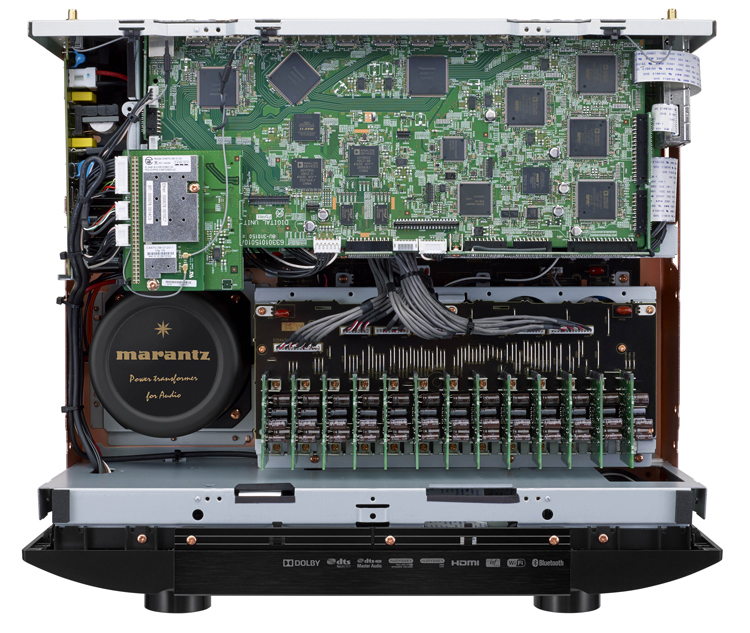
Marantz improved the design of the AV8802 in several key areas. The HDAM (Hyper Dynamic Amplifier Module) circuitry is upgraded to HDAM-SA2, which Marantz also used to improve the quality of the XLR outputs and lower the overall noise floor.
A Cirrus Logic CS2100 clock generator was used to reduce jitter. The DAC was upgraded to an AKM 4490, which supports native DSD. Marantz also borrowed design concepts for the transformer in the AV8802 from the Marantz PM-11S3 reference stereo integrated amplifier and used four custom Nichicon 10,000μF capacitors in the AV8802 to ensure adequate power reserve.
From an internal perspective, Secrets’ Dr. David Rich offered this analysis on the design of the AV8802:
“The AV8802 is similar in design to the AV8801 in the analog path but a significant improvement has been made to the output circuitry. The output circuitry is now a pair of fully discrete, fully complementary, current mode opamps per channel. The first discrete opamp is wired as a unity gain buffer (10 transistors) and interfaces between the Renesas R2A15220FP LSI and the RCA output jack. The output also goes to the positive output pin of the XLR (pin 2).
The other discrete opamp is wired as a unity gain inverter (14 transistors) and is connected from the output of the non-inverting buffer to the negative output pin of the XLR (pin 3). Current draw for the 26 discrete buffers is +/- 320mA.
The buffers are powered by a +/- 12V DC power supply. The unregulated rails for the discrete output buffers are produced by a separate transformer winding which would have had the function of supplying the power amp in an AVR. For the AVR the transformer winding would be at a much higher voltage.
RCA and XLR output anti-pop on power up muting function is performed by relays.
The signal to noise ratio of the AV8802 is improved over the AV8801 with the output stage redesign. The AV8801 output stage had a gain of two. The AV8802 output stage is now unity gain. The noise from the volume control block, which is the dominate noise source in the analog signal path, is not increased by the output stage in the AV8802. The signal at the output of the DAC, which is before the volume control, is doubled in the AV8802 to compensate for the gain reduction at the output.
The Analog Devices ADSP21487 DSP chips are used in the AV8802. Each ADSP21487 performs 2700 32 bit MLFOPs (Mega Floating-Point Operations per Second). MFLOP is a figure of merit for DSP performance.
Four DSPs are used in used in the AV8802. It is easy to pipeline DSPs in a Surround Sound Processor since different functions are assigned to different DSP. For example, ATMOS decoding could occur in one DSP, room correction in another, bass management in a 3rd and Dolby® TrueHD decode in the 4th.
The ADSP21487 has an on board Asynchronous Sample Rate Converters (8 channels). In the measurements, we see the fundamental has less FM sideband indicative of the reduction of jitter on the HDMI clock. Unfortunately, we see several spurs uncorrelated to the fundamental in these spectra. This may indicate some correlated jitter between the clocks of the 4 DSPs but this is just one of several possible explanations.
The number of DSPs used in the AV8802 and the computational power of each is the result of the addition of ATMOS decoding and the need to process 11.2 channels instead of the standard 7.1.
The DAC is changed from a TI PCM1795 in the AV8801 to the AKM AK4490 in the AV8802. The worst case signal to noise declines from 120dB to 115dB but worst case distortion improves from 0.001% to 0.0006%. The distortion measurements are for a full scale signal at a data rate of 44.1k samples /sec. The AKM AK4490 supports DSD. The schematic shows data signal marked DSD coming from both chips associated with HDMI and USB.
The ADC remains the AKM AK5358B.
A +/- 7V power supply is used for the analog audio circuits outside the output buffer. This supply is derived from its own transformer winding. This supply powers the Renesas R2A15220FP LSI chips (two are required given the additional height channels), SSI opamps and other analog circuitry is at +/-7V. The DACs and ADC power supply is down regulated from the +7V supply. The fine line analog CMOS technology in the DACs and ADC is limited to a 5V supply.
All digital circuits are supplied from a large 5V digital switching power supply. These are locally down regulated by 11 switching DC to DC converters to the sub-blocks of this very complex piece of electronics. All the digital chips dissipate approximately 40 Watts which makes high efficiency switching power supplies mandatory. “
In order to enjoy 3D surround formats like Dolby Atmos, you need to have at least one pair of height speakers in the listening room with two pair being ideal. The AV8802 supports traditional height speakers that you might find in a Dolby PLIIz configuration, in-ceiling or top speakers, and of course Dolby Atmos enabled speakers which have upward-firing drivers to reflect the sound off of the ceiling and towards the listener. If you aren’t familiar with the basics of Dolby Atmos and Auro-3D, Secrets’ Senior Editor Chris Eberle has provided a great introduction in his article: “Dolby Atmos and Auro-3D: The Technology and The Reality.”
The number of speaker configurations that the AV8802 supports is impressive. Options start with a 5.1.2 speaker configuration and expand to a 7.1.4 speaker configuration, and even a 9.1.2 speaker configuration, which includes front-wide speakers.
Speaker configurations can include up to four subwoofers and unused channels can even be used to bi-amp the front main channels. While all of this sounds overwhelming, Marantz has made the AV8802 a dream to set up by continuing to enhance their on-screen setup assistant. I simply connected the AV8802 to my TV with an HDMI cable, turned on the AV8802 and the TV, and followed the on-screen directions.
The first part of the setup assistant guides you through connecting the AV8802 to the amplifiers and connecting the speakers to the amplifiers. During the connection process, the power amplifiers need to be turned off. The on-screen directions are very clear and cover the basics of proper speaker wiring as well as speaker placement in the listening room.
The setup assistant helps you to select the speakers that are present in your system, and for each speaker selected, it asks you to specify the connection type of RCA or XLR. The setup assistant also shows you where to connect the cable from the amplifier to the AV8802. Marantz has even included a set of speaker labels so that you can mark each cable during the process.
Out of the box, the AV8802 does not come with the Auro-3D upgrade installed, so I initially configured the AV8802 in a Dolby Atmos configuration with a pair of Front-Height speakers and a pair of Top-Middle in-ceiling speakers. Once the speakers are connected and the amplifiers turned on, the AV8802 plays a few musical notes to help identify all the channels.
This is a really elegant touch and allows for finding problems in the speaker configuration before starting room correction. The setup assistant then walks you through the Audyssey room calibration process. I mounted the Audyssey microphone to a tripod, connected the microphone to the AV8802, and started the measurement process. If you don’t have a tripod, Marantz includes a cardboard microphone stand which you can assemble to get the job done.
The Audyssey calibration process verifies the speaker configuration as measured from the primary listening position, and also checks the subwoofer levels. For my setup, I was using a GoldenEar Technology TritonCinema One system, which features a pair of Triton One speakers with built-in subwoofers. I connected the subwoofer outputs of the AV8802 to the LFE inputs on the Triton One speakers.
Since Marantz has included Audyssey SubEQ HT technology, the Audyssey setup process verified that each subwoofer was playing at around 75dB before starting the calibration process. I proceeded with the calibration process, and after completing eight sets of measurements, the AV8802 created the Audyssey room correction filters. The last steps in the process are to disconnect the microphone, and decide on enabling Audyssey Dynamic EQ, which I did for all inputs. I also made one manual change to the Audyssey settings for my configuration, which was to set the Front Left/Right speakers to Large, which is the recommended configuration for the Triton One speakers.
The setup assistant then walks you through making a connection to the internet and verifies the connection by tuning the AV8802 to an internet radio station. The last step in the setup process is to connect each of your source devices to the AV8802. The setup assistant prompts you to select each source and specify the type of video and audio connection. I connected my satellite DVR, an Oppo BDP-105 and my AppleTV to the AV8802 and was finally done with the setup process. The entire process took about half an hour and was very straightforward.
I used the AV8802 for a while just with Dolby Atmos, but was eager to add the Auro-3D functionality. The Auro-3D upgrade costs $199 and can be purchased from the Marantz web site. Once the upgrade is authorized by Marantz, an upgrade message will appear when the AV8802 is powered on, or you can check for a feature update in the “Setup/General /Firmware” menu. Once the Auro-3D feature firmware is downloaded and installed, the setup assistant opens back up, and walks you through the Auro-3D setup.
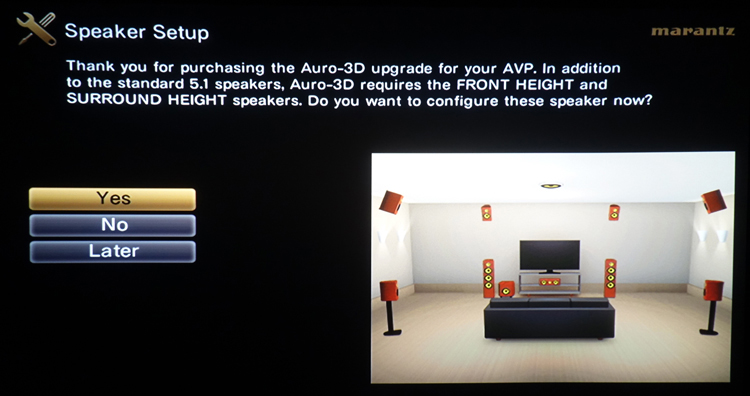
On the AV8802, Auro-3D requires two sets of height speakers, specifically Front -Height and Surround -Height speakers. In my case, I already had the Front-Height speakers in my configuration and I was able to use the Top-Middle speakers as Surround-Height speakers for Auro-3D. If you are wondering how I was able to do this, I was using a pair of GoldenEar Technology Invisa HTR 7000 speakers as my Top-Middle speakers.
The driver in the HTR 7000 is angled towards the listening position, so they work beautifully for both Dolby Atmos and as Surround-Height speakers for Auro-3D. In my listening room, the Top-Middle speakers are also placed closer to the sides of the room, so that was another plus. I answered “yes” and went on to the next step.
I should point out that the only height speakers that are common between Auro-3D and Dolby Atmos are the Front-Height speakers. Auro-3D does not support Top-Front, Top-Middle, or Top-Rear speakers and it does not support any Dolby Atmos enabled speakers or Dolby Atmos elevation modules.
All the speakers used for Auro-3D must be direct-radiating speakers, so keep this in mind if you are thinking of building a home theater compatible for both formats. Marantz will be publishing a future firmware upgrade that will allow the Rear Height channels to be shared between all three 3D surround formats. This means that a room can be configured for Front-Height and Rear-Height and the speakers will be compatible with Dolby Atmos, Auro-3D and DTS:X.
The next question asks about the Auro-3D Top Surround or Voice of God (VOG) channel, which is a single optional speaker mounted directly above the listening position. If you want to use the VOG channel on the AV8802, then you give up having independent support for two subwoofers since the VOG channel connects to the Subwoofer 2 pre out. In my case, I didn’t have this channel, so I continued on with the setup.
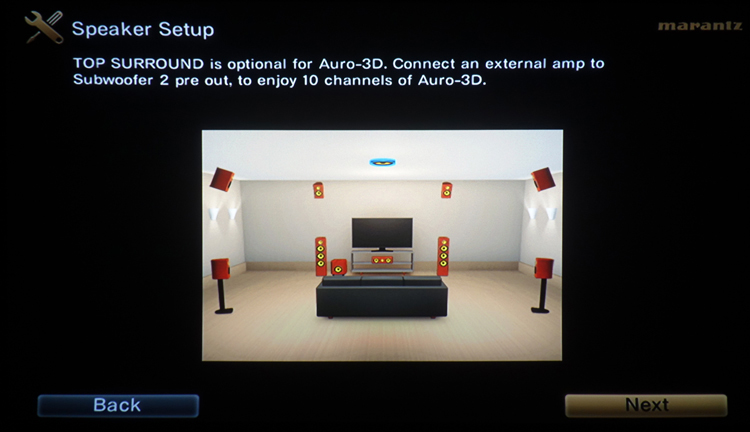
The next step is a question about surround back channels. Auro-3D doesn’t use surround back channels, but they will be used when listening to non-Auro-3D formats like Dolby Atmos or Dolby Surround. In my case, I have surround back speakers, so I answered “yes.”
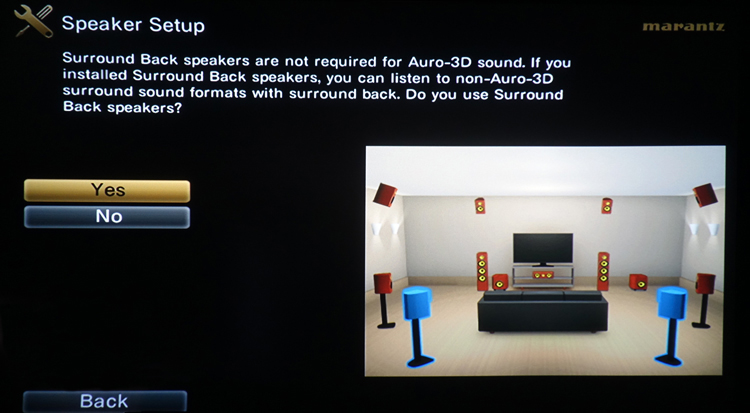
With the questions out of the way, you’re done setting up Auro-3D, but you still have to go back through Audyssey room correction to re-measure the new configuration. In my case, I could argue that I didn’t really change anything, but the AV8802 will not be able to apply the Audyssey technology unless the room is re-measured. The setup assistant walks you back through the entire Audyssey process. The only difference is that the room layout pictures are updated to reflect the new Auro-3D speaker configuration.
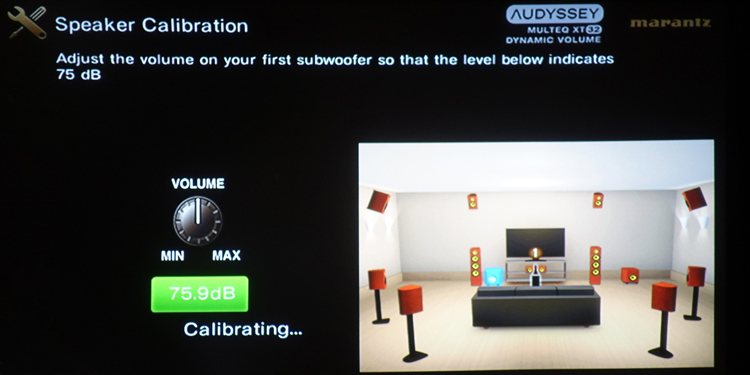
As my last step in the setup process, I downloaded the Marantz Remote App to my Apple iPad.
In my listening environment, I used a 7.1.4 GoldenEar Technology Triton One system with a pair of Triton One front speakers with powered subwoofers, a GoldenEar SuperCenter XXL center channel, two pair of GoldenEar Invisa HTR 7000 as surround / top-middle height and rear surrounds, a pair of GoldenEar Aon 2 speakers for surrounds, and a pair of GoldenEar SuperSat 3 as front height speakers.
I used a McIntosh MC8207 amplifier for my main and surround channels. To power the height channels, I used a Rotel RMB-1095 5-channel amp and Rotel RMB-1080 2-channel amp. I only needed four channels of amplification, but having the extra two amps allowed me to independently power two pair of height speakers. This came in handy when listening to just the height speakers by themselves to get a perspective on what the height speakers were actually adding to the listening experience.
I used an Oppo BDP-105 as my primary source device and started using the Marantz AV8802 configured only for Dolby Atmos, with a pair of Front-Height and a pair of Top-Middle speakers. I was already sold on Dolby Atmos after my experience with the Integra DHC-80.6, so I was really looking forward to hearing the combination of the AV8802 and the GoldenEar Triton One system.

Dolby Atmos is all about creating an immersive listening experience. In “American Sniper,” Clint Eastwood tells the story of U.S. Navy SEAL sniper Chris Kyle. The soundtrack offers plenty of opportunity to experience Dolby Atmos. From the deep rumbling bass of tanks, to the sounds of helicopters filling the room, to the frightening decay of sniper fire echoing across the listening room, the AV8802 drew me into the action. As a dust storm approaches, the AV8802 effortlessly filled the room with the smothering sound of whipping sand. The sound track was incredibly engaging and helped to tell the tragic story of this American Hero.

In the opening scenes of “Unbroken,” the AV8802 transformed my listening room into a dramatic air battle with the sounds of attacking aircraft and exploding ordinance. The AV8802 drew me into the amazing life of Olympian Louis Zamperini and his unforgettable story of survival and forgiveness. The AV8802 had no trouble handling the most dynamic of scenes, like the plane crashing into the ocean.
My experience with the AV8802 continued to enforce how much I liked the added dimension of the height channels. While it’s very cool to have overhead effects like rain storms and plane flyovers, the vast majority of the time the benefit comes from the added ambiance that’s been added to the listening room. That ambiance can come from the soundtrack itself, or it could just be the sound of the ocean and the wind which adds to the dramatic effect of being lost at sea for 47 days in “Unbroken.”
I have been fortunate to experience a number of fantastic Dolby Atmos titles on the AV8802, including “Gravity”, “Insurgent”, “The Age of Adaline”, and “Mad Max Fury Road.” In combination with the GoldenEar Triton One system, the AV8802 brought all of these movies to life with an immersive theater-like ambiance, a huge soundstage, natural dialog, and outstanding detail. The AV8802 handled the most dramatic sound effects, dynamic movie scores, and the quietest moments with ease.
While I enjoyed sampling the Dolby Atmos soundtracks, I was also impressed with the Dolby Surround upmixer on the AV8802, which creates a 3D surround experience from existing content. The upmixer created a much more immersive presentation, with improved dynamics and a much greater sense of space and realism. I found this to be the case with some of my favorite movies and television shows.
My impressions of Dolby Atmos and the AV8802 at this point were very clear. I loved the ambiance that the height channels added to my listening room and I was dying to experience Auro-3D. I reconfigured the AV8802 for Auro-3D with my Top-Middle speakers reconfigured as Surround-Height speakers and reran the Audyssey setup.
Listening to the Auro-3D demo disc at this point was simply incredible. Music and movie clips sounded amazing and exceedingly natural, and I immediately found myself wanting more Auro-3D content.

I picked up a copy of “Souvenir” from TrondheimSolistene (the Trondheim Soloists). The disc is available from Amazon and 2L in Norway. The 9.1 channel Auro-3D presentation is simply stunning. The gorgeous sound of Pyotr Illyich Tchaikovsky’s “Souvenir de Florence” filled the room and transported me to the Selbu Church in Norway to experience this amazing chamber orchestra. The sound of the string instruments was so natural and the height channels provided a lovely ambiance. This is an outstanding demo disc and it also contains soundtracks mixed in 5.1 DTS-HD MA 24/192 kHz, 7.1 DTS-HD MA 24/96 kHz, as well as a 2.0 LPCM track recorded in 24/192 kHz.
The AV8802 sounded great with all types of music and I appreciated how well the Audyssey Dynamic EQ processing worked at all volume levels. Since Dynamic EQ is referenced to the standard level used for mixing movies, the Reference Level Offset must be adjusted in order to properly apply the correct amount of equalization. Options for the Reference Level Offset range from 0 dB for movies, 5 dB for classical music, 10 dB for TV or jazz, and 15 dB for pop and rock music.
I found that Dynamic EQ overly compressed the sound for my tastes unless I properly adjusted the Reference Level Offset. Unfortunately, it was extremely frustrating that there was no quick way to adjust the Reference Level Offset without a lengthy trip through the Audio Setup menu. Marantz offered me two alternatives to make this process simpler. The first was to use the Smart Select function of the remote, which allows for the creation of up to four presets.
Each preset can select input source, volume, sound mode, Audyssey options, and even channel levels and picture adjustments. The second option was a third-party remote app called DeRemote for Denon and Marantz. The $5 app is available for iOS devices and offers extensive control of many Denon and Marantz AV receivers and processors, including control of the Audyssey settings.
The Auro-3D music presentations were definitely a whole new experience. Having the front height channels in the configuration, whether for Auro-3D or Dolby Atmos, also opens up a wide array of processing options including Audyssey DSX, Neo:X as well as the Auro-3D upmixer. The AV8802 will display an on-screen menu, which allows you to scroll through the available sound modes that are available for any given source and speaker configuration, so you can explore the formats to your liking.
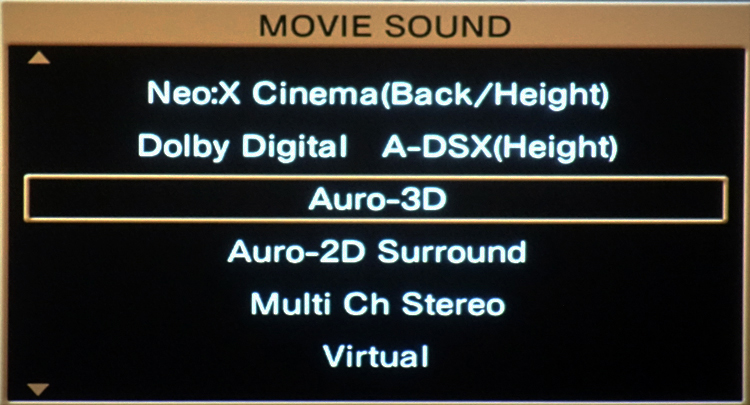
The AV8802 also offers a very useful “Info” display which will show the current sound mode, input signal, Audyssey settings, input signal channels, and the active speakers. This display illustrates the compromises that are made with the speaker configurations between Dolby Atmos and Auro-3D. For example, here is what happens on the AV8802 when a 5.1 Dolby Digital soundtrack is played using the Auro-3D upmixer.
You’ll notice that the Surround Height channels are engaged, but no information is sent to the rear channels. I found myself missing the rear speakers since I was used to experiencing sound coming from behind my listening position. In this case, I preferred the sound of the Dolby Surround upmixer over the Auro-3D upmixer.

Here’s what happens when a Dolby Atmos movie is played on the AV8802 with an Auro-3D speaker configuration. The surround back channels are engaged, but the surround height channels are not used at all. I found that this compromised the sound effects that were intended to go directly overhead.

To get around these limitations, I decided to just try manually changing the speaker layout in the “Speakers/Amp Assign” menu. With this menu, it is a simple matter to reselect a different speaker layout, Front Height and Top Middle in my case, and the AV8802 will use the new speaker configuration.

Unfortunately, there is one big problem with this approach. Look at what happens when I listen to a Dolby Atmos soundtrack after manually changing the speaker configuration from the Auro-3D configuration. The input signal is properly identified as Dolby Atmos, and the channels are all there as expected including Top Middle. The downside is that all the Audyssey processing is gone, which defeats the entire point of having room correction in this case.
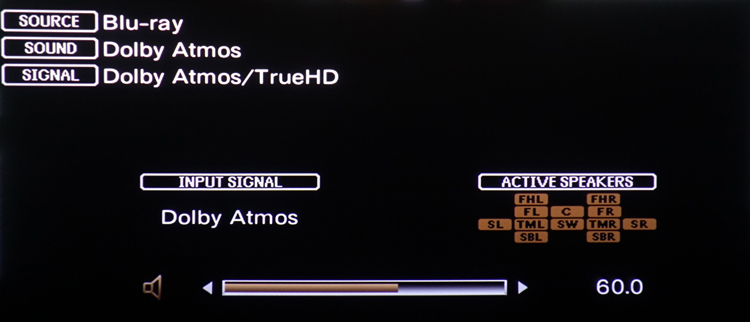
The only solution is to rerun the Audyssey setup one more time in order to correct for the configuration change. If you do happen to change the speaker layout and change your mind, it is a simple matter to just return the speaker configuration to what you started with, and the Audyssey settings will be back to normal. After living with the AV8802 for an extended period of time, I found that I preferred having the AV8802 configured for Dolby Atmos and then I would manually change the configuration if I wanted to explore Auro-3D.
I would like to experience a lot more Auro-3D content, but at this point there is a limited supply. I found the benefits of Dolby Surround and Dolby Atmos far outweighed having the convenience of supporting both formats at the expense of losing channels between the configurations. I would like to see Marantz offer the option of two independent configurations for both formats and maintain two separate Audyssey configurations. When Marantz releases the firmware update to support Front-Height and Rear-Height speakers across Dolby Atmos, Auro-3D and DTS:X, this will become a non-issue as long as you can accommodate that speaker configuration.
From a video perspective, the AV8802 did not display any handshake problems when changing resolutions on my satellite box or when changing inputs to another HDMI source. I used the AV8802 in passthrough mode which is the default configuration. We will talk more about the video performance in the benchmark.
Operationally, the AV8802 is very easy to use and similar to the AV8801. The remote that comes with the AV8802 gets the job done, but doesn’t have the best backlighting. The AV8802 is DLNA 1.5 certified, and supports Apple AirPlay and Bluetooth. The AV8802 also supports a wide array of audio formats including WMA, MP3, WAV, MPEG-4 AAC, FLAC, ALAC, AIFF and DSD. It also supports network streaming services like Pandora, SiriusXM, Spotify and Vtuner. If all that isn’t enough, Marantz offers a very nice remote app for both Apple and Android.
I should also note that Marantz now plays digital sources in Zones 2 and 3 which is a welcome improvement over the AV8801.
My standard benchmark tests were done using two-channel bypass mode so that all digital signal processing was off. On tests using the XLR input, I measured the XLR preamp output of the AV8802. On tests using an RCA input, I measured the RCA preamp output of the AV8802. The source device for both analog and HDMI tests was an Oppo BDP-105. For the analog tests, the input level was 2.2 VRMS into the XLR inputs of the AV8802. The volume was adjusted for 2 VRMS at the XLR outputs of the AV8802.
At 1 kHz into the XLR input, THD+N was 0.001692%. We see a few harmonics throughout the spectrum with the second harmonic at 2 kHz being about 95 dB below 2 VRMS.
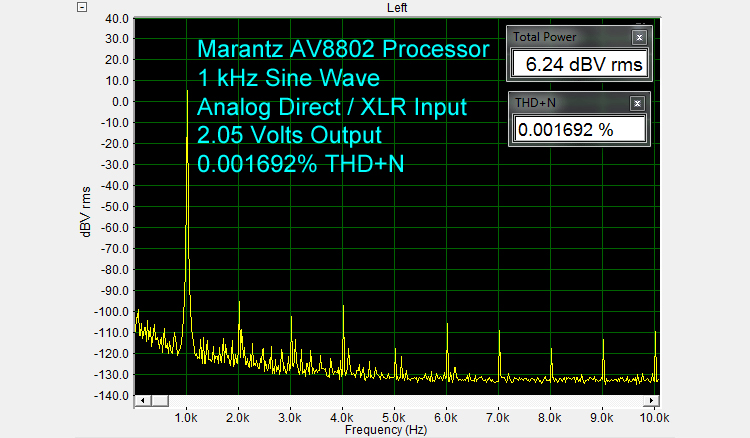
At 1 kHz into the RCA input, THD+N was 0.001629%. We see a few harmonics throughout the spectrum with the second harmonic at 2 kHz being about 95 dB below 2 VRMS. The volume was increased 6 dB to bring the single ended output to 2 VRMS with a 1.1 VRMS signal level applied to the RCA input. The major difference between this and the previous graph is related to the voltage difference. For a power amplifier with the typical gain of 20 (26dB), a 2 VRMS RCA input is required to produce 200 Watts out into 8 ohms. With 2 VRMS balanced as shown in the previous graph, you only have 1 VRMS single ended, which is what runs internally inside the AV8802. In this test, we have 2.07 VRMS single ended with no increase in distortion which is excellent.
For the XLR tests at 2 VRMS, a power amp with a gain 20V/V will have a power output of only 50 Watts, which is why we also supply 5 VRMS tests which will take the power amp to 300 Watts.
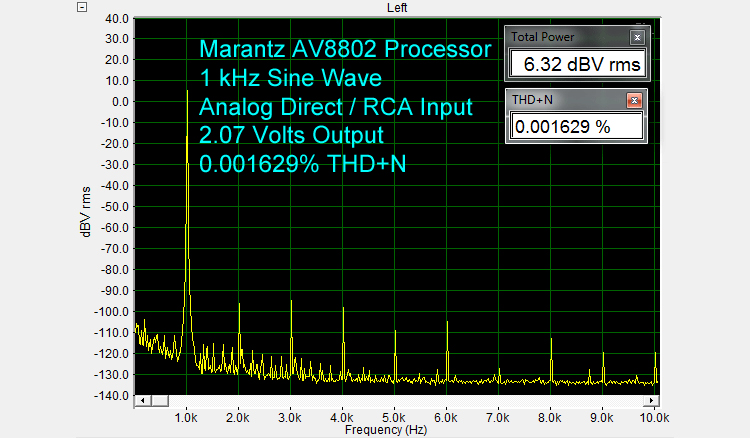
At 10 kHz into the XLR input, THD+N was 0.007151%. The second harmonic at 20 kHz is about 81 dB below 2 VRMS.
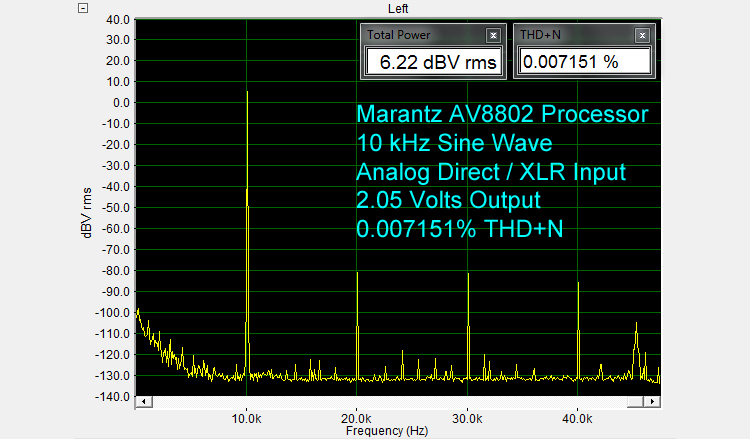
At 10 kHz into the RCA input, THD+N was 0.002672%. Compared to the previous test, we see a decrease in distortion despite the higher 2.07 VRMS single ended. The second harmonic at 20 kHz is about 94 dB below 2 VRMS. The third harmonic at 30 kHz is about 88 dB below 2 VRMS.
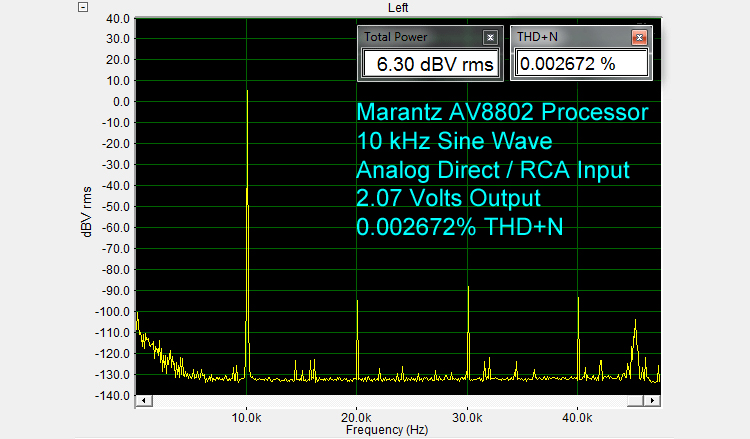
The IMD measurement using the XLR input was 0.000617%. We see noise spurs on either side of the fundamentals and a second harmonic at 14 kHz at 114 dB below 2 VRMS.

The IMD measurement using the RCA input was 0.001066%. The performance is worse compared to the previous graph due to the higher internal voltage of 2.03 VRMS single ended.
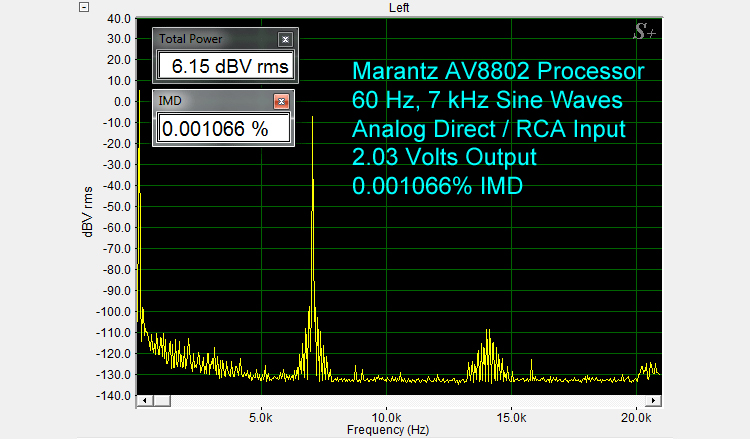
Here are the results for 19 kHz, 20 kHz combined test frequencies using the XLR input. There is a visible B-A peak at 1 kHz about 91 dB below 2 VRMS. We see distortion spurs throughout the spectrum. The second harmonics at 38 kHz and 40 kHz are about 106 dB below 2 VRMS (6 dBV).
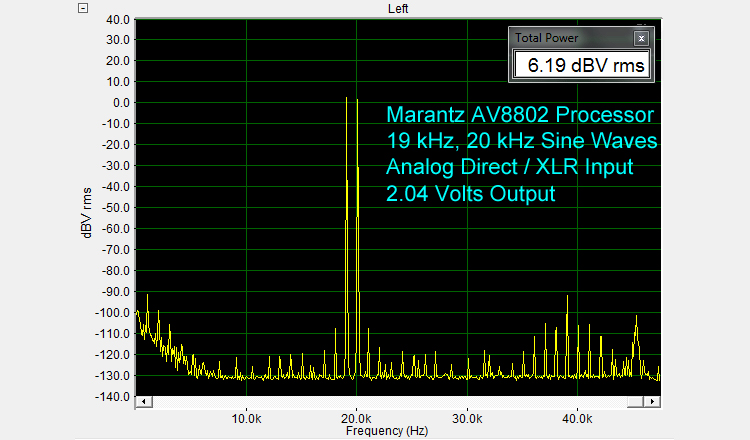
Here are the results for 19 kHz, 20 kHz combined test frequencies using the RCA input. There is a visible B-A peak at 1 kHz about 89 dB below 2 VRMS. We see distortion spurs throughout the spectrum. The second harmonics at 38 kHz and 40 kHz are about 101 dB below 2 VRMS.
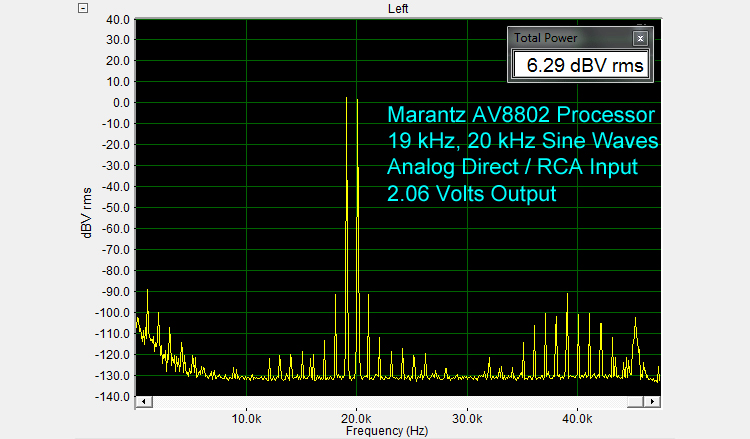
I measured the frequency response of the AV8802 out to 96 kHz. In analog direct, the response is flat out to about 50 kHz and then we see a very gradual 5 dB roll-off of the high frequencies. The second plot shows what happens in stereo mode with digital signal processing and Audyssey XT32 enabled. The AV8802 downsamples the signal to 48 kHz and applies any room correction filters for each channel. You can clearly see the inverse of the room correction curve in the plot. The signal then abruptly falls off around 24 kHz. This result isn’t surprising since we’ve seen this same downsampling with the AudysseyXT32 implementation in the AV8801.

Now we take a look at the results using one of the HDMI inputs, fed from test discs played on an OPPO-BDP-105. At 1 kHz, and 16-bit/44.1k sampling rate, THD+N was 0.000927% measured from the XLR preamp output. We see several harmonics in the spectrum with the peak at 2 kHz being about 101 dB below 2 VRMS. For all digital tests, the DAC was driven at -5 dBFS and the volume adjusted for 2 VRMS at the output.
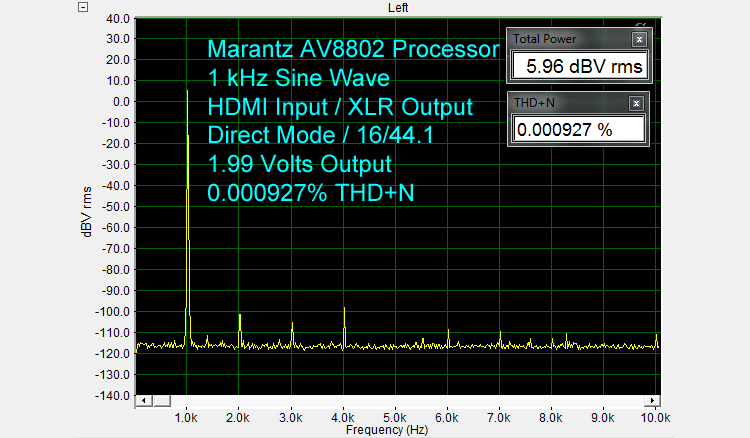
At 1 kHz, and 16-bit/44.1k sampling rate, THD+N was 0.001287% measured from the RCA preamp output, which is slightly higher than the previous test. We see some distortion spurs as well as harmonics throughout the spectrum with the peak at 2 kHz being about 103 dB below 2 VRMS. As with the analog direct tests, the volume was increased 6 dB to bring the single ended output to 2 VRMS with the same -5 dBFS digital input to the DAC.
The remaining tests are for XLR only.
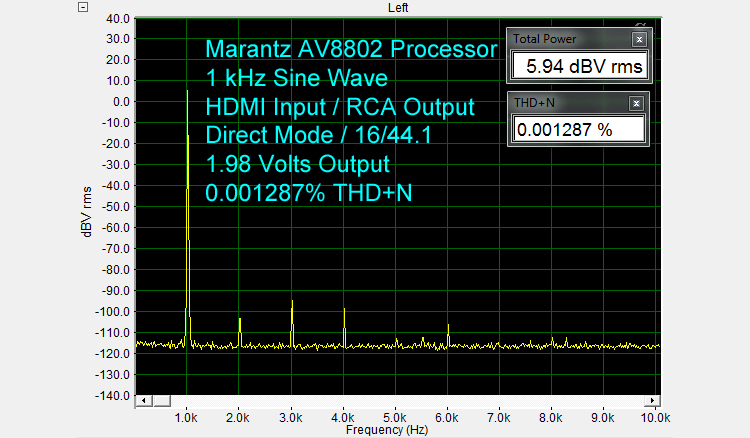
At 1 kHz, and 24-bit/96k sampling rate, THD+N was 0.001165%. We see some distortion spurs as well as harmonics throughout the spectrum with the second harmonic at 2 kHz being about 102 dB below 2 VRMS. In the measurements, we can see the benefits of the Asynchronous Sample Rate Converters in the ADSP21487 DSPs. We see the fundamental has less FM sideband indicative of the reduction of jitter on the HDMI clock. Unfortunately, we see several spurs uncorrelated to the fundamental in these spectra.
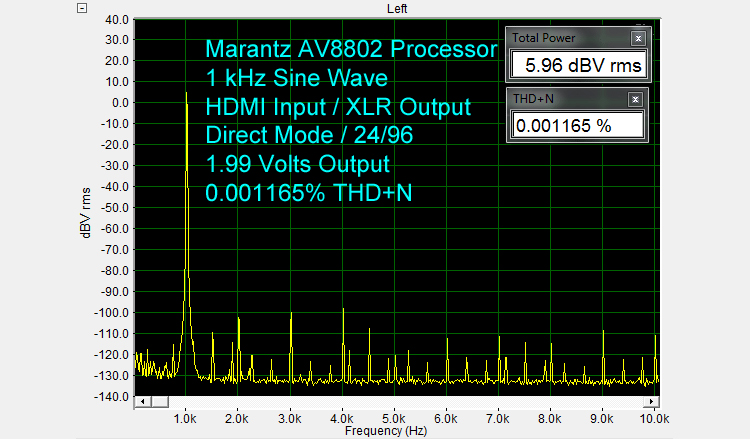
At 1 kHz, and 24-bit/96k sampling rate, THD+N was 0.002056% at 5.0 VRMS. We see numerous distortion spurs as well as harmonics throughout the spectrum with the third harmonic at 3 kHz being about 81 dB below 5 VRMS.
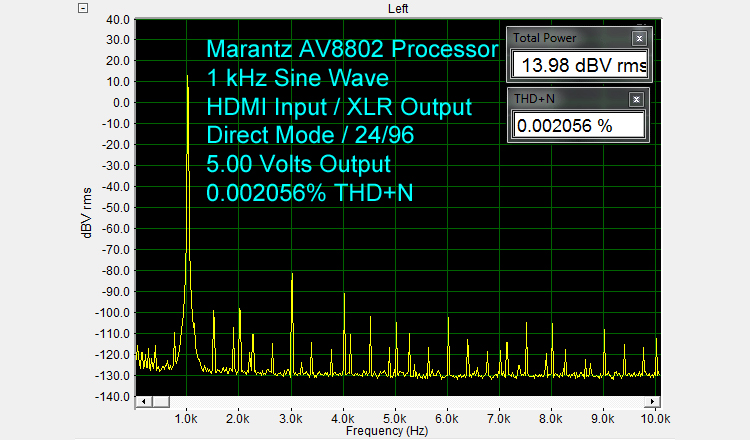
At 1 kHz, and 24-bit/192k sampling rate, THD+N was 0.001435% at 2 VRMS.
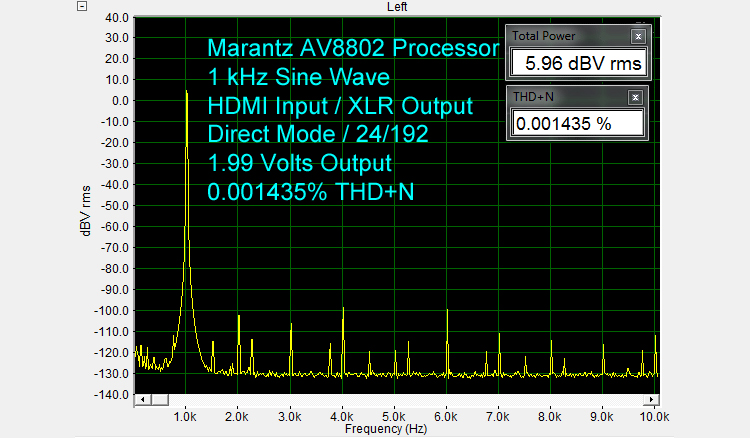
At 10 kHz, and 16-bit/44.1k sampling rate, THD+N was 0.002299% at 2 VRMS. We see some distortion spurs in the spectrum with the second harmonic at 20 kHz being about 90 dB below 2 VRMS.
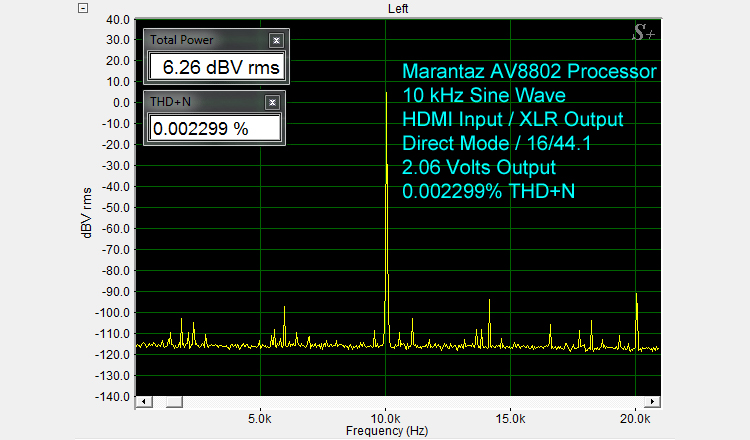
At 10 kHz, and 24-bit/96k sampling rate, THD+N was 0.001714% at 2 VRMS. We see numerous distortion spurs in the spectrum with the second harmonic at 20 kHz being about 92 dB below 2 VRMS.
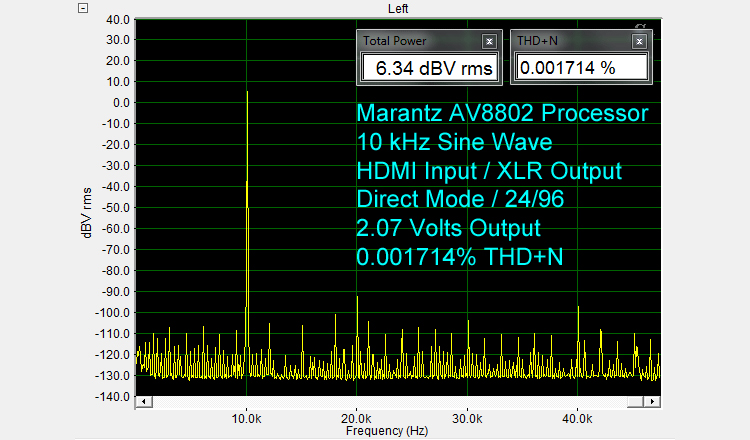
At 10 kHz, and 24-bit/96k sampling rate, THD+N was 0.003578% at 4.95 VRMS. We see numerous distortion spurs in the spectrum with the second harmonic at 20 kHz being about 78 dB below 5 VRMS.
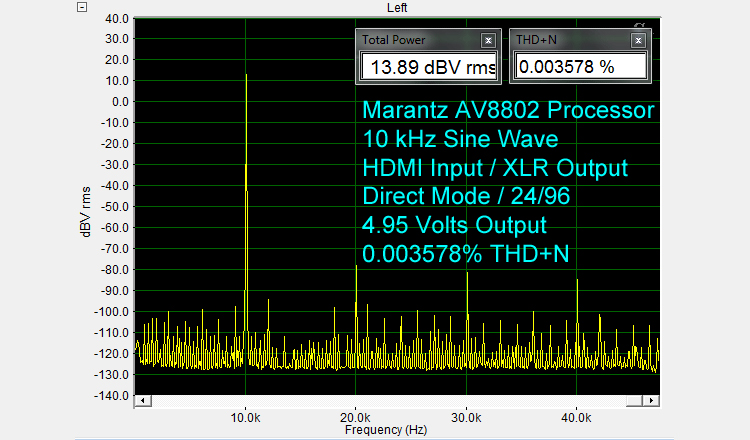
At 10 kHz, and 24-bit/192k sampling rate, THD+N was 0.002308% at 2 VRMS. We see numerous distortion spurs in the spectrum with the second harmonic at 20 kHz being about 91 dB below 2 VRMS.
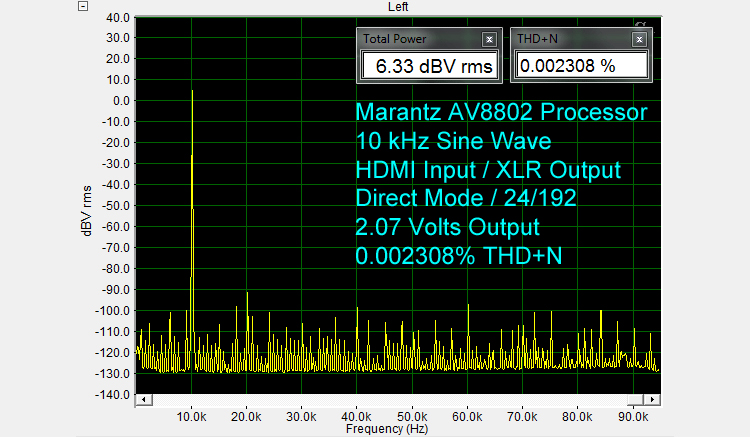
The IMD measurement through HDMI at 16-bit/44.1k sampling was 0.000515% at 2 VRMS.
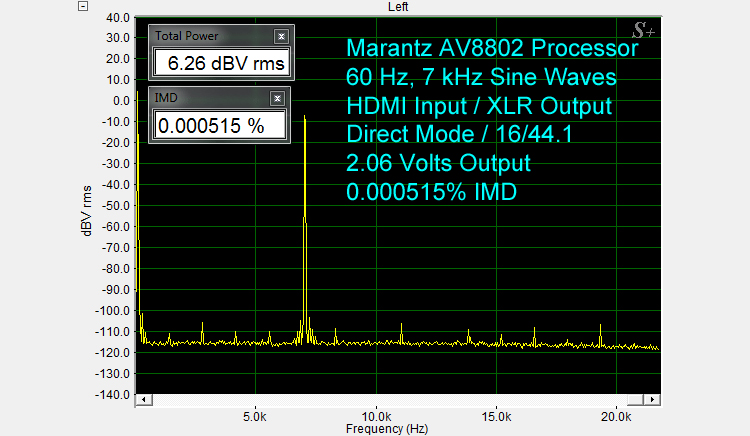
The IMD measurement at 24-bit/96k sampling rate was 0.000385%. We see numerous distortion spurs in the spectrum with the second harmonic at 14 kHz being about 118 db below the 60 Hz tone at 2 VRMS.
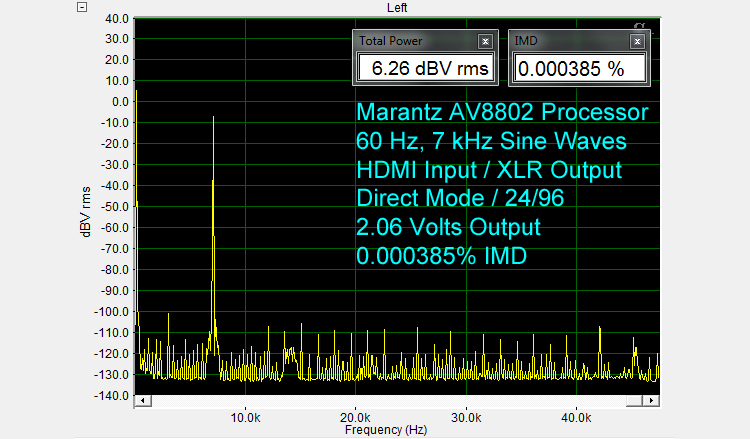
The IMD measurement at 24-bit/96k sampling rate was 0.002144% at 5.19 VRMS. We see similar results with the second harmonic at 14 kHz being about 112 db below the 60 Hz tone at 5 VRMS.
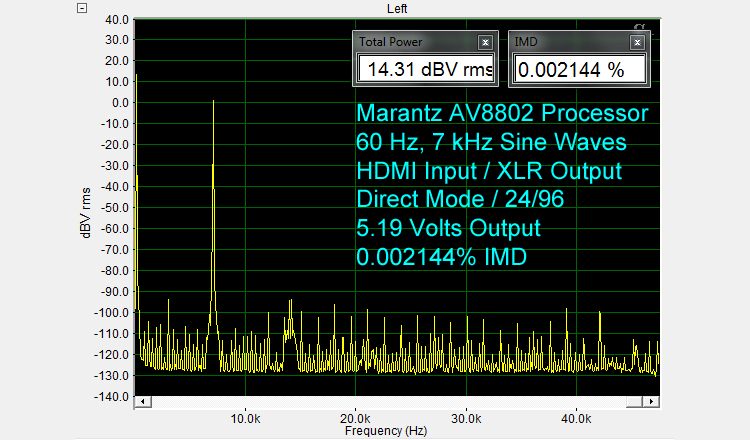
The IMD measurement at 24-bit/192k sampling rate was 0.002324% at 2 VRMS.

Here are the results for the 19 kHz, 20 kHz combined test frequencies using the HDMI input with 16-bit/44.1k sampling at 2 VRMS. There is a visible B-A peak at 1 kHz about 89 dB below each test tone at 1 VRMS which is insignificant. For this test, the digital input for both the 19 kHz and 20 kHz test tones is -11 dBFS. This produces two analog tones at 1 VRMS (0 dBV RMS) each. In the time domain, the two 1 VRMS tones have a peak-peak value of a single tone at 2 VRMS.
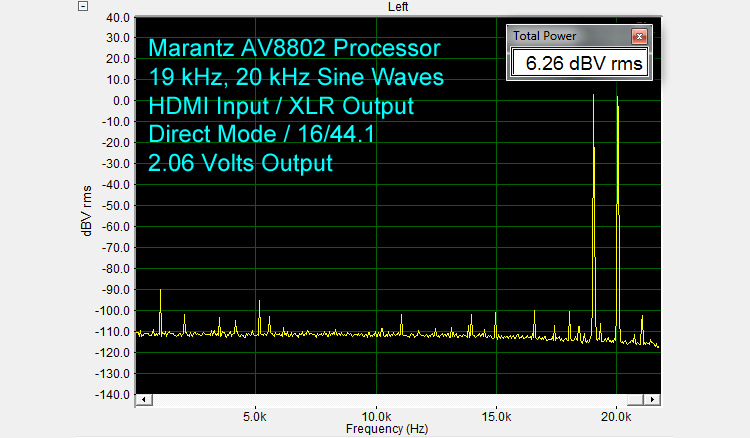
Here are the results for the 19 kHz, 20 kHz combined test frequencies using the HDMI input with 24-bit/96k sampling at 2 VRMS. We see distortion spurs throughout the spectrum. There is a visible B-A peak at 1 kHz about 94 dB below each test tone at 1 VRMS which is insignificant. The second harmonics at 38 kHz and 40 kHz are about 98 dB respectively below 1 VRMS.

Here are the results for the 19 kHz, 20 kHz combined test frequencies using the HDMI input with 24-bit/96k sampling at 5 VRMS. We see higher distortion spurs throughout the spectrum. There is a visible B-A peak at 1 kHz about 80 dB below each test tone at 2.5 VRMS. The second harmonics at 38 kHz and 40 kHz are about 81 dB below each test tone at 2.5 VRMS.

Here are the results for the 19 kHz, 20 kHz combined test frequencies using the HDMI input with 24-bit/192k sampling at 2 VRMS. As in the previous test, there are distortion spurs throughout the spectrum. The second harmonics at 38 kHz and 40 kHz are about 99 dB below each test tone.
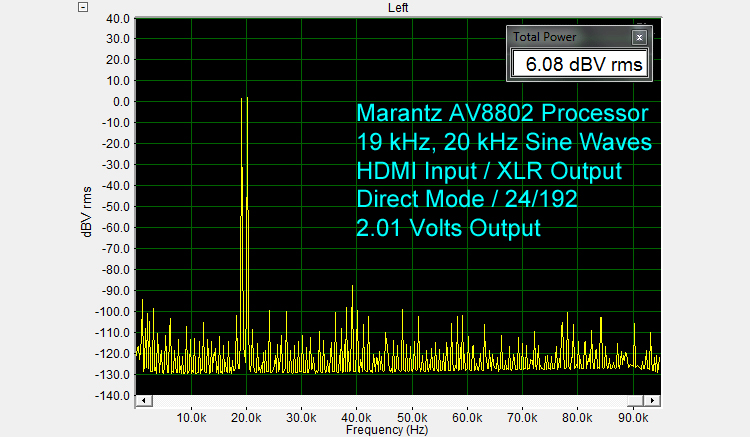
On the video side of things, the AV8802 passed all our standard tests except for the chroma-multiburst test, which indicated a loss of very fine detail when the internal video processor is used. By default, the video processing is turned off and the AV8802 is in bypass mode, so this will not be an issue for most users.
THE MARANTZ AV8802 is the best 11.2-channel processor that I’ve used this year and is highly recommended.
- Immersive 3D surround experience
- Audyssey Platinum Suite
- Really easy to use and configure with settings that can be changed per input
- Dolby Atmos and optional Auro-3D
- Hardware upgradeable to HDMI 2.0a, HDCP 2.2, Rec. 2020, HDR
- Includes Apple and Android control app
- The ability to store two independent sets of speaker configurations and Audyssey calibrations for Dolby Atmos and Auro-3D
- More flexibility in sharing channels between Dolby Atmos and Auro-3D
- A popup menu that allows for the configuration of Audyssey parameters
- An option in the control app for Apple and Android to modify the Audyssey parameters, especially the Reference Level Offset for Dynamic EQ
- A remote with a better backlight
- TEXT
The Marantz AV8802 is a great benchmark for a flagship A/V preamp/processor. It is loaded with state-of-the-art functionality and yet the AV8802 is incredibly easy to use and configure. The inclusion of Dolby Atmos and Dolby Surround is a given in the marketplace today, but the inclusion of an option for Auro-3D and a future upgrade path to DTS:X is reassuring to the consumer, especially at a time when a format war over 3D immersive sound formats seems inevitable. The fact that Marantz has already planned for a hardware upgrade to make the AV8802 ready for HDMI 2.0a and 4K HDR is also an enormous plus, and once again shows a commitment to the consumer.
After experiencing Dolby Atmos and Auro-3D in my own home theater, I can’t imagine having a theater without some type of height channels. The AV8802 easily delivers on the promise of 3D audio formats by creating an immersive, theater-like experience. I applaud Marantz for making the coexistence of formats like Auro-3D and Dolby Atmos possible. They still have room for improvement in managing the Audyssey configurations across the 3D formats, and it might be nice if they offered the ability for more user control over speaker assignments. Some of the issues of speaker compatibility are definitely owned by Dolby and Auro Technologies, but over time, we will hopefully see all these formats happily coexist. I am definitely looking forward to seeing more Auro-3D coming to the marketplace.
If you are looking for a new 11.2 channel processor, the Marantz AV8802 is a sure bet. Its only competition currently comes from other products in the Marantz and Denon product lineup, but that gives the consumer some choice in terms of feature-set and budget. In the future, the folks at Emotiva may give the AV8802 some serious competition if they bring an 11.2 channel version of the XMC-1 to market. For now, the Marantz AV8802 is the best 11.2-channel processor that I’ve used this year and is highly recommended.
The author would like to thank Dr. David Rich for his contributions on this article.


